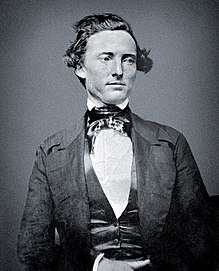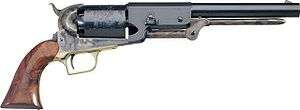Samuel Hamilton Walker
| Samuel Walker | |
|---|---|
 Samuel Hamilton Walker, circa 1846 | |
| Born |
Samuel Hamilton Walker February 24, 1817 Toaping Castle, Maryland, United States |
| Died |
October 9, 1847 (aged 30) Huamantla, Tlaxcala, Mexico |
| Occupation | Army Captain, Texas Ranger |
| Spouse(s) | Ali Walker |
| Children | 15 |
Samuel Hamilton Walker (February 24, 1817 – October 9, 1847) was a Texas Ranger captain and military officer of the Republic of Texas and the United States armies. Walker served in several armed conflicts, including the American Indian Wars and the Mexican-American wars.
Biography
Samuel Hamilton Walker was born on February 24, 1817 at Toaping Castle, Maryland, to Nathan and Elizabeth (Thomas) Walker, and was the fifth of seven children.[1]
Military
Walker enlisted in the Washington City Volunteers for the Creek Indian Campaign in Alabama in 1836. The following year he mustered out and worked as a scout in Florida until 1841. He arrived in Galveston, Texas in 1842 and served under Captain Jesse Billingsley against a Mexican invasion led by General Adrian Woll. Walker was captured on December 26, 1842 and marched to Mexico City as a prisoner of war. He survived what became known as the Black Bean Episode and was held prisoner for two years before he escaped to Louisiana and returned to Texas.[2][3]
He joined the Texas Rangers in 1844 under the command of Captain John Coffee Hays. Promoted to captain, he led a Ranger company during the Mexican–American War, serving with General Zachary Taylor and General Winfield Scott's armies.[4]
Walker Colt

Walker is best known as the co-inventor of the famous Walker Colt revolver, along with arms manufacturer Samuel Colt. Walker is said to have self-funded a trip to New York City to meet with Colt and proposed to him the concept of a weapon based on the then-popular five-shot Colt Paterson revolver, with many enhancements such as adding a sixth round, being powerful enough to kill either a man or a horse with a single shot and quicker to reload .[5]
Colt's firearms company was no longer in business, but the large order allowed Colt to establish a new company. He hired Eli Whitney, Junior, already in the arms business, to make his new revolvers.[6] Colt asked Samuel Walker, who happened to be temporarily stationed in Washington, to help him with the design.[7]
Colt used his prototype and Walker's improvements to create a new design. Blake produced the first thousand-piece order, known as the Colt Walker. The company then received an order for an additional one thousand more. Colt's share of the profits was $10.[6]
By 1847, the new revolver was available. The United States Army's mounted rifle companies were issued them, and they proved extremely effective.[8]

Death
Walker was killed on October 9, 1847, at Huamantla, in Tlaxcala, while leading his troops in the Battle of Huamantla during the Mexican–American War. He was struck down by a shotgun (escopeta) fired from a balcony, although popular legend claim he was killed by a lance.[9]
The following year, his remains were moved to San Antonio. On April 21, 1856, as part of a battle of San Jacinto anniversary memorial, Walker was reburied in the Odd Fellows' Cemetery at San Antonio.[10]
Walker County, Texas, was renamed for him after the original namesake, Robert J. Walker, sided with the Union during the Civil War.[11]
See also
References
- ↑ Charles D. Spurlin. "WALKER, SAMUEL HAMILTON". Handbook of Texas Online (See "Notes" section). Texas State Historical Association. Retrieved May 2, 2011.
- ↑ Glasrud, Bruce A.; Weiss, Harold J. (2012). Tracking the Texas Rangers: The Nineteenth Century. University of North Texas Press. pp. 90–92. ISBN 978-1-57441-465-3.
- ↑ Herrera-Sobek, María (2012). Celebrating Latino Folklore: An Encyclopedia of Cultural Traditions. ABC-CLIO. p. 722. ISBN 978-0-313-34339-1.
- ↑ Bauer, K. Jack (1 August 1993). Zachary Taylor: Soldier, Planter, Statesman of the Old Southwest. LSU Press. p. 150. ISBN 978-0-8071-1851-1.
- ↑ Rick Sapp (2007). Standard Catalog of Colt Firearms. F+W Media, Inc,. pp. 35–40. ISBN 978-0-89689-534-8.
- 1 2 Adler, Dennis (2008). Colt Single Action: From Patersons to Peacemakers. Edison, New Jersey: Chartwell Books. p. 62. ISBN 978-0-7858-2305-6.
- ↑ Gwynne, S.C. (2010). Empire of the Summer Moon. New York, NY: Scribner. p. 149. ISBN 978-1-4165-9105-4.
- ↑ "New pistols" (PDF). Texas Ranger Museum.
- ↑ "Walker's Walkers: The Colt Walker Revolvers of Captain Samuel H. Walker, Texas Ranger" (PDF).
- ↑ Franscell, Ron (9 November 2010). Crime Buff's Guide to Outlaw Texas. Rowman & Littlefield. p. 77. ISBN 978-0-7627-7493-7.
- ↑ Cox, Mike (7 September 2015). Gunfights & Sites in Texas Ranger History. Arcadia Publishing Incorporated. p. 47. ISBN 978-1-62585-487-2.
Further reading
- K. Jack Bauer, The Mexican War, 1846–1848 (New York: Macmillan, 1974).
- Albert Gallatin Brackett, General Lane's Brigade in Central Mexico (Cincinnati and New York: Derby, 1854).
- Edmund L. Dana, "Incidents in the Life of Capt. Samuel H. Walker, Texan Ranger," Proceedings of the Wyoming Historical and Geological Society (1882).
- "Reminiscences of the War with Mexico, As Told by Col. Thos. Claiborne," Vedette 7 (April 1886). Marilyn M. Sibley, ed., Samuel H. Walker's Account of the Mier Expedition (Austin: Texas State Historical Association, 1978).
- Charles D. Spurlin, "Ranger Walker in the Mexican War," Military History of Texas and the Southwest 9 (1971).